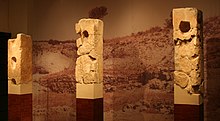Roquepertuse
Coordinates: 43 ° 32 ′ 0 ″ N , 5 ° 15 ′ 0 ″ E
Roquepertuse is where a Celtic oppidum was found and a sanctuary of the Saluvii.
The place is near the town of Velaux in Provence ( France ). According to the current state of research (resumption of research from 1988, new excavations by Brigitte Lescure from 1991) there was at least one craftsman's and one residential area in addition to the building complex that was interpreted as a sanctuary. According to the current reading, it was attacked by the Romans in 124 BC. Completely destroyed, but the time of the destruction is also earlier in the 2nd century BC. Possible.
Roquepertuse was discovered in 1860, but was not excavated until 1923 by Henri de Gérin-Ricard .
Finds
The finds are dated to the 3rd century BC. Dated. The clothing and posture of the statues found, however, indicate a higher age (5th century BC / 6th century BC).
- a two-faced, androgynous sculpture called: Hermes (0.2 meters high)
- three columns with cavities for human skulls ( Celtic head cult )
- two statues in " Buddha pose"
- a large bird (0.62 meters high)
- a frieze with horse heads
The most important finds are exhibited in the Musée d'Archéologie Méditerranéenne in Marseille , the bird sculpture in the Musée d'histoire de Marseille .
The fall of the sanctuary
During the Second Punic War , the Romans formed an alliance with the Greek colony of Massalia (Marseille). Celts living near this city threatened the colonies and attacked Roman legions on their way to Spain. The Greeks called on their federal partner for help and Rome organized in 124 BC. A first punitive expedition. The Celts initially defended themselves successfully. The Romans lost some soldiers and withdrew. Roman sources report that the barbarians beheaded the bodies of the Romans and nailed the mummified skulls to the walls of their sanctuaries and houses.
A second expedition followed in the following year, led by the consul Gaius Sextius Calvinus . The troops now marched on with throwing machines that hurled stone balls weighing 6 kilograms. The Romans posted these weapons on the mountain slopes of the capital Entremont and at the Roquepertuse sanctuary. After a few days, the Celts gave up and fled, while the Romans completely destroyed Entremont and Roquepertuse. The wooden buildings collapsed and burned. Reconstruction was forbidden and the Legion founded the new town nearby: Colonia Aquae Sextia , today's Aix-en-Provence . The people of the salyes was eliminated and replaced by other Celts, Romans and Greeks. Roquepertuse and Entremont were never rebuilt.
Characteristic features of the "Hermes" sculpture
The 5-10 percent difference in skull size indicates a combination of a male and female person or an androgynous god. The sculpture exhibits a property of an androgynous deity (documented in Plato's Symposium and in The Zohar ) that the two faces cannot see each other.
literature
- Henri de Gérin-Ricard: Le sanctuaire préromain de Roquepertuse à Velaux . Marseille 1929
- Fernand Benoit: L'art primitif méditerranéen de la vallée du Rhone . 1955
- Fernand Benoit: Art et dieux de la Gaule . 1969
- Brigitte Lescure: The Celto-Ligurian "sanctuary" of Roquepertuse . In: Sanctuaries and sacrificial cults of the Celts , special issue Archeology in Germany , 1995
- Jonas Scherr: Roquepertuse ( DNP Addenda et Corrigenda). In: Orbis Terrarum 11, 2012/2013, pp. 243-251.


